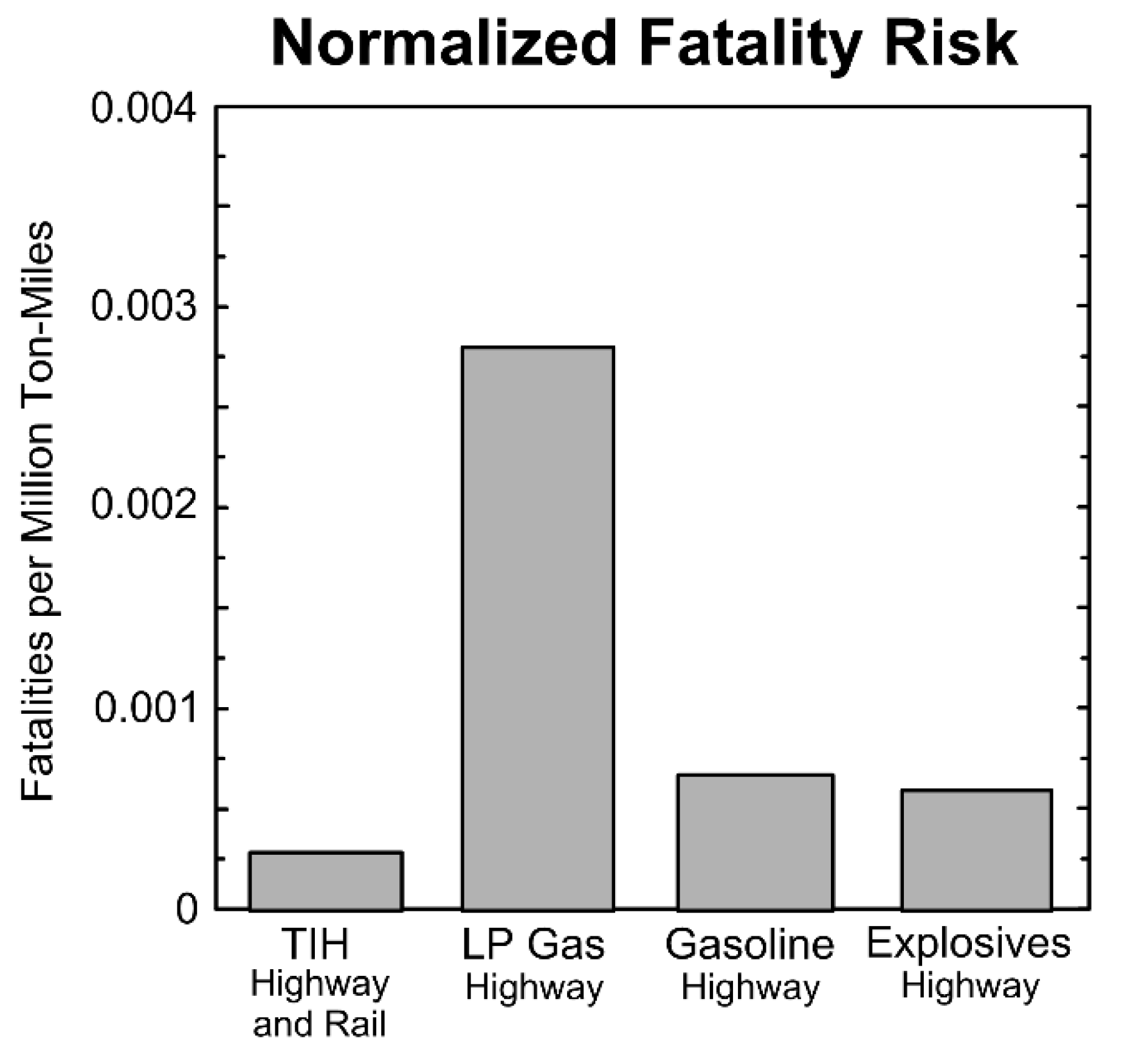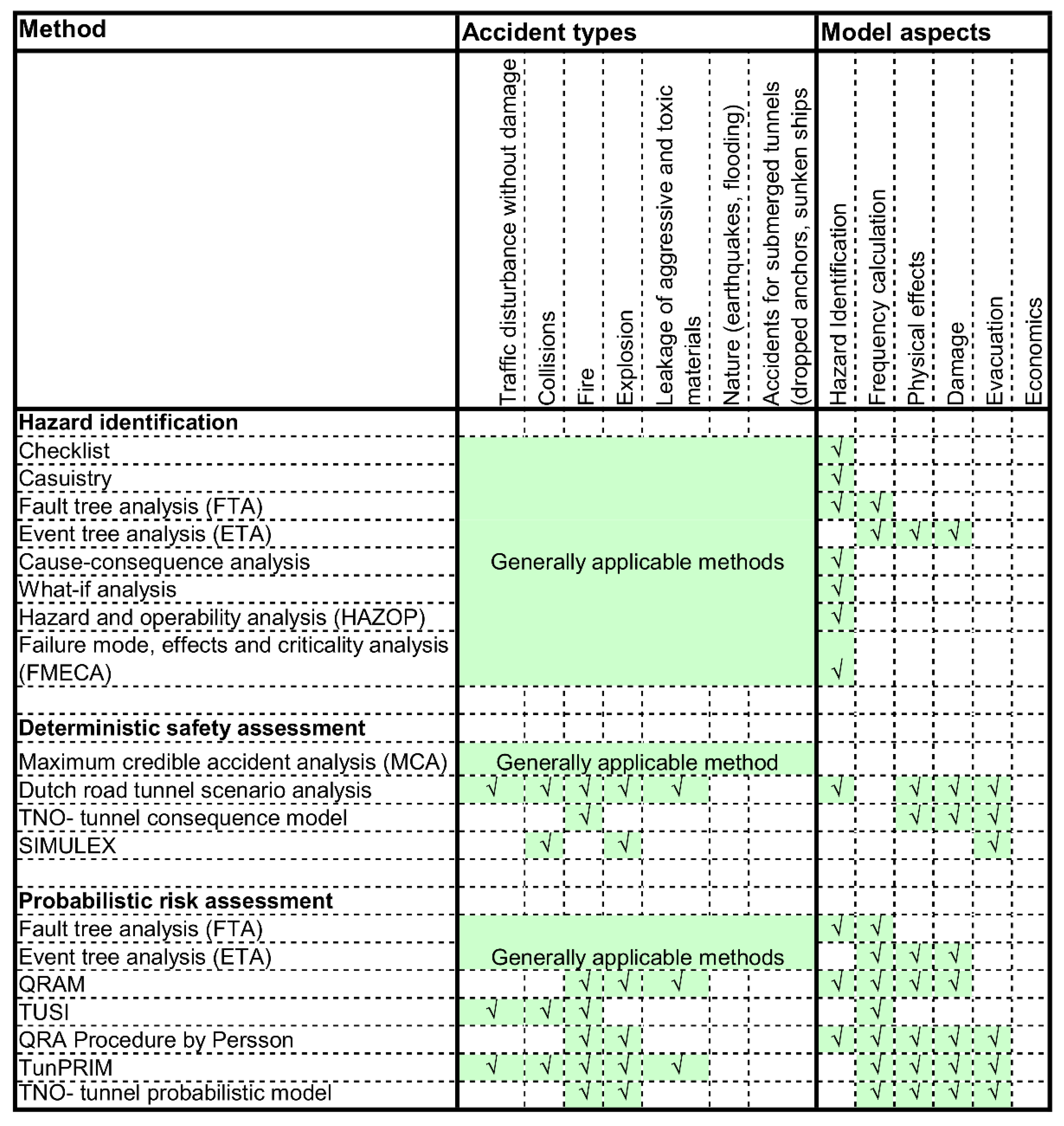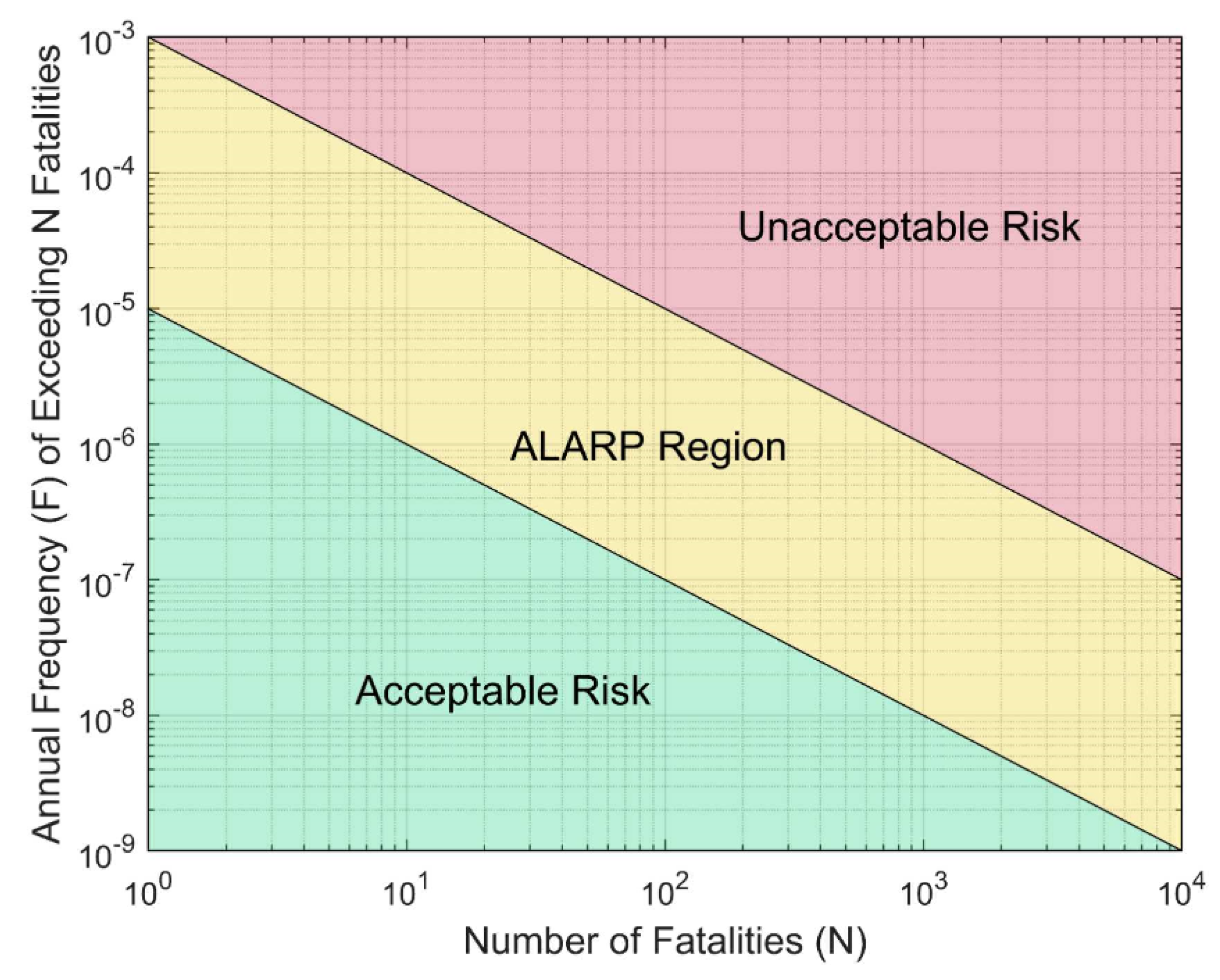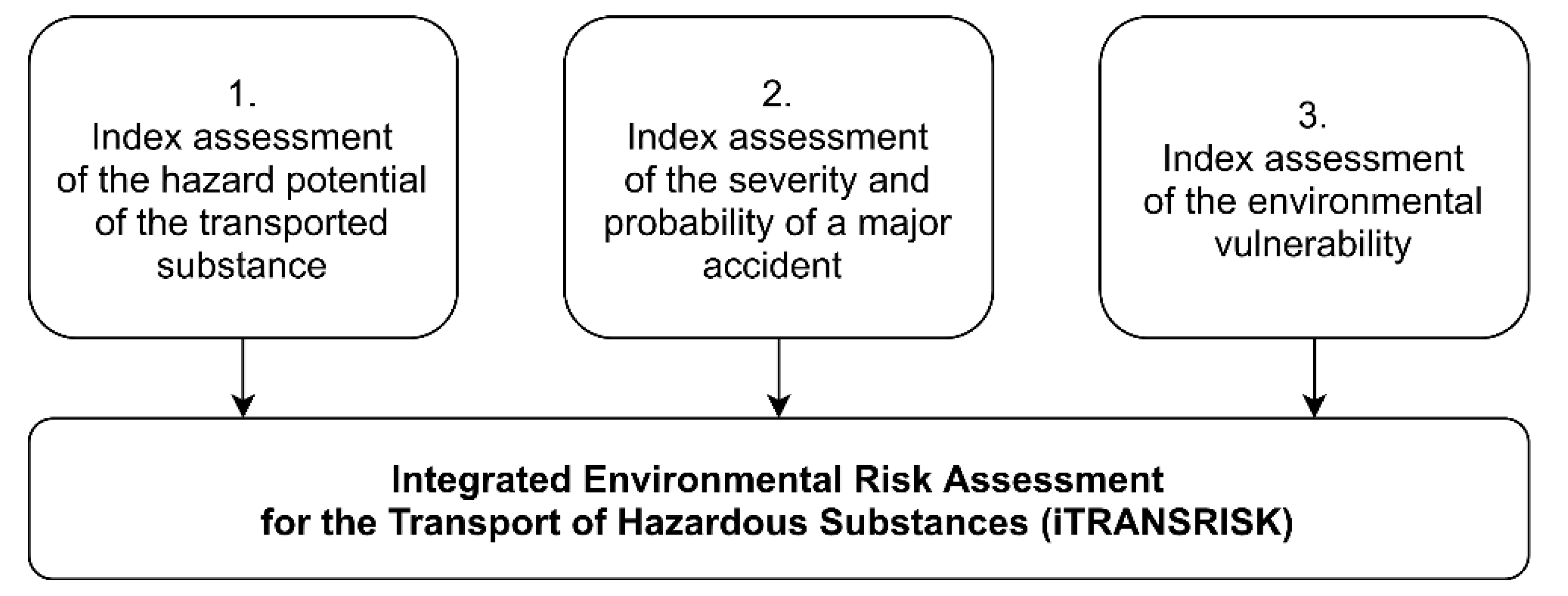Integrated Environmental Risk Assessment of Major Accidents in the Transport of Hazardous Substances
Abstract
:1. Introduction
2. Materials and Methods
2.1. Accidents and Their Impacts
2.2. Methods for Major Accident Risk Assessment
2.2.1. Major Accident Scenarios in the Transport of Hazardous Substances
2.2.2. Modelling of Hazardous Substance Release Scenarios during Transport
2.2.3. Limits of Social Risk
2.3. Approaches to Environmental Vulnerability Assessment
3. Results
3.1. Integrated Approach to Environmental Risk Assessment of Accidents in the Transport of Hazardous Substances
3.2. Environmental Risk Assessment Procedure for Accidents in the Transport of Hazardous Substances
- Step 1: Defining the Basic Parameters for the Transport of a Hazardous Substance
- Step 2: Defining a Scenario for the Leakage of Hazardous Substances During Transport
- Step 3: Defining the Setting of a Major Accident with a Release of a Hazardous Substance
- Step 4: Determining the Hazard Potential Index of the Transported Substance
- Step 5: Determining the Severity Index and Probability of a Major Accident
- Step 6: Determining the Environmental Vulnerability Index
- Step 7: Determining the Environmental Risk Index
- Step 8: Assessment of the Acceptability of Environmental Risk
- 1; 1; 1; 1; 1 → ⌀ 1.0
- 1; 1; 1; 1; 125 → ⌀ 25.8
- 1; 1; 1; 125; 125 → ⌀ 50.6
- 1; 1; 125; 125; 125 → ⌀ 75.4
- 1; 125; 125; 125; 125 → ⌀ 100.2
- 125; 125; 125; 125; 125 → ⌀ 125.0
3.3. Discussion
4. Conclusions
Author Contributions
Funding
Institutional Review Board Statement
Informed Consent Statement
Conflicts of Interest
References
- Council Directive 2012/18/EU of 4 July 2012 on the Control of Major-Accident Hazards Involving Dangerous Substances; Office for Official Publications of the European Communities: Luxembourg, 2012.
- ISO 31000. Risk Management—Guidelines; International Organization for Standardization: Geneva, Switzerland, 2018. [Google Scholar]
- Zhang, J.; Zhao, L. Risk Analysis of Dangerous Chemicals Transportation. Syst. Eng.-Theory Pract. 2007, 27, 117–122. [Google Scholar] [CrossRef]
- Milazzo, M.F.; Lisi, R.; Maschio, G.; Antonioni, G.; Spadoni, G. A Study of Land Transport of Dangerous Substances in Eastern Sicily. J. Loss Prev. Process. Ind. 2010, 23, 393–403. [Google Scholar] [CrossRef]
- Saat, M.R.; Werth, C.J.; Schaeffer, D.; Yoon, H.; Barkan, C.P.L. Environmental Risk Analysis of Hazardous Material Rail Transportation. J. Hazard. Mater. 2014, 264, 560–569. [Google Scholar] [CrossRef] [PubMed]
- Zelenko, Y.; Dzhus, O.; Dzhus, V.; Yanchenko, D. Methodology of Risk Assessment and Forms of Environmental Safety Management for the Transport of Dangerous Goods by Railway Transport. In Proceedings of the 2nd International Scientific and Practical Conference “Energy-Optimal Technologies, Logistic and Safety on Transport” (EOT-2019), Lviv, Ukraine, 19–20 September 2019; Volume 294. [Google Scholar] [CrossRef]
- Ehrhart, B.D.; Brooks, D.; Muna, A.B.; LaFleur, C. Evaluation of Risk Acceptance Criteria for Transporting Hazardous Materials; Sandia National Laboratories: Albuquerque, NM, USA, 2020.
- Saska, T. Risk Quantification for Environment Elements along the Traffic Route. Trans. VSB—Tech. Univ. Ostrav. Saf. Eng. Ser. 2012, 7, 37–43. [Google Scholar] [CrossRef] [Green Version]
- Macias, A.; Gadziński, J. Assessment of Road Transport Environmental Impact as Illustrated by a Metropolitan Area. Pol. J. Environ. Stud. 2013, 22, 1749–1758. [Google Scholar]
- Häkkinen, J.; Malk, V.; Posti, A.; Penttinen, O.P.; Mäkelä, R.; Kiiski, A. Environmental Risk Assessment of the Most Commonly Transported Chemicals: Case Study of Finnish Coastal Areas. WMU J. Marit. Aff. 2013, 12, 147–160. [Google Scholar] [CrossRef] [Green Version]
- Conca, A.; Ridella, C.; Sapori, E. A Risk Assessment for Road Transportation of Dangerous Goods: A Routing Solution. Transp. Res. Procedia 2016, 14, 2890–2899. [Google Scholar] [CrossRef] [Green Version]
- Dvorak, Z.; Rehak, D.; David, A.; Cekerevac, Z. Qualitative Approach to Environmental Risk Assessment in Transport. Int. J. Environ. Res. Public Health 2020, 17, 5494. [Google Scholar] [CrossRef]
- Popek, M. Factors Influencing on the Environment during Hazardous Goods Transportation by the Sea. In Proceedings of the IOP Conference Series: Earth and Environmental Science, Krakow, Poland, 14–17 November 2017; Volume 214. [Google Scholar] [CrossRef]
- Li, H.; Deng, Q.; Zhang, J.; Olubunmi Olanipekun, A.; Lyu, S. Environmental Impact Assessment of Transportation Infrastructure in the Life Cycle: Case Study of a Fast Track Transportation Project in China. Energies 2019, 12, 1015. [Google Scholar] [CrossRef] [Green Version]
- Oggero, A.; Darbra, R.M.; Munoz, M.; Planas, E.; Casal, J. A Survey of Accidents Occurring During the Transport of Hazardous Substances by Road and Rail. J. Hazard. Mater. 2006, 133, 1–7. [Google Scholar] [CrossRef]
- Center for Chemical Process Safety. Guidelines for Chemical Transportation Risk Analysis; Wiley-AIChE: New York, NY, USA, 1995. [Google Scholar]
- Brown, D.F.; Dunn, W.E.; Policastro, A. A National Risk Assessment for Selected Hazardous Materials Transportation; Argonne National Laboratory: Lemont, IL, USA, 2001. [CrossRef] [Green Version]
- Mannan, S. Lees’ Loss Prevention in the Process Industries: Hazard Identification, Assessment and Control, 4th ed.; Butterworth-Heinemann: Oxford, UK, 2012. [Google Scholar] [CrossRef]
- Center for Chemical Process Safety. Guidelines for Chemical Process Quantitative Risk Analysis (CPQRA), 2nd ed.; Wiley-AIChE: New York, NY, USA, 1999. [Google Scholar]
- Center for Chemical Process Safety. Layer of Protection Analysis: Simplified Process Risk Assessment; Wiley-AIChE: New York, NY, USA, 2001. [Google Scholar]
- Van den Bosch, C.J.H.; Weterings, R.A.P.M. Methods for the Calculation of Physical Effects: Due to Releases of Hazardous Materials (Liquids and Gases) “Yellow Book”, 3rd ed.; Sdu Uitgevers: The Hague, The Netherlands, 2005. [Google Scholar]
- Uijt de Haag, P.A.M.; Ale, B.J.M. Guidelines for Quantitative Risk Assessment “Purple Book”, 3rd ed.; Sdu Uitgevers: The Hague, The Netherlands, 2005. [Google Scholar]
- Delvosalle, C.; Fievez, C.; Pipart, A.; Debray, B. ARAMIS project: A comprehensive methodology for the identification of reference accident scenarios in process industries. J. Hazard. Mater. 2006, 130, 200–219. [Google Scholar] [CrossRef] [PubMed]
- Molag, M.; Trijssenaar-Buhre, I.J.M. Risk Assessment Guidelines for Tunnels. In Proceedings of the 2nd International Symposium Safe & Reliable Tunnels: Innovative European Achievements, Lausanne, Switzerland, 30–31 May 2006. [Google Scholar]
- IEC 60812. Failure Modes and Effects Analysis (FMEA and FMECA); International Electrotechnical Commission: Geneva, Switzerland, 2018. [Google Scholar]
- INERIS. Transport of Dangerous Goods through Road Tunnels, Quantitative Risk Assessment Model (v. 3.60 and v. 3.61). User’s Guide and Reference Manual; French National Institute for Industrial Environment and Risks: Verneuil-en-Halatte, France, 2005. [Google Scholar]
- Bouissou, C.; Ruffin, E.; Defert, R.; Prats, F.; Dannin, E. A new QRA Model for Rail Transportation of Hazardous Goods. In Proceedings of the 11th International Symposium on Loss Prevention and Safety Promotion in the Process Industry, Prague, Czech Republic, 31 May–3 June 2004; pp. 4283–4289. [Google Scholar]
- Pribyl, P.; Janota, A.; Spalek, J. Risk Analysis and Management in Transport; BEN—Technická Literatura: Prague, Czech Republic, 2008. (In Czech) [Google Scholar]
- ALOHA Software. Agency. Available online: https://www.epa.gov/cameo/aloha-software (accessed on 16 July 2021).
- EFFECTS Advanced, Easy-To-Use Consequence Analysis. Available online: https://www.tno.nl/media/10741/effects-brochure.pdf (accessed on 19 July 2021).
- TEREX—TERrorism EXpert. Available online: https://www.tsoft.cz/teroristicky-expert/ (accessed on 20 July 2021).
- Ball, D.J.; Floyd, P.J. Societal Risk; Health and Safety Executive: Bootle, UK, 1998.
- Ale, B.J.M. Tolerable or Acceptable: A Comparison of Risk Regulation in the United Kingdom and in the Netherlands. Risk Anal. 2005, 25, 231–241. [Google Scholar] [CrossRef] [PubMed]
- Tarada, F.; Bopp, R.; Nyfeler, S. Ventilation and Risk Control of the Young Dong Rail Tunnel in Korea. In Proceedings of the 1st International Conference on Major Tunnel and Infrastructure Projects, Taipei, Taiwan, 22–24 May 2000. [Google Scholar]
- Alwang, J.; Siegel, P.B.; Jørgensen, S.L. Vulnerability: A View from Different Disciplines. In Social Protection Discussion Papers and Notes; World Bank Group: Washington, DC, USA, 2001; p. 23304. [Google Scholar]
- Weißhuhn, P.; Müller, F.; Wiggering, H. Ecosystem Vulnerability Review: Proposal of an Interdisciplinary Ecosystem Assessment Approach. Environ. Manag. 2018, 61, 904–915. [Google Scholar] [CrossRef] [PubMed] [Green Version]
- Takasawa, H. Update on the Rapid Environment and Health Risk Assessment Project; Working Group on Monitoring and Assessment: Helsinki, Finland, 2002. [Google Scholar]
- Ministry of the Interior. Guideline for the Performance of Environmental Risk Assessment (within the Framework of Royal Decree 1254/1999 SEVESO II); Directorate General for Civil Protection and Emergencies: Madrid, Spain, 2003.
- Scott, A. Environment–Accident Index: Validation of a Model. J. Hazard. Mater. 1998, 61, 305–312. [Google Scholar] [CrossRef]
- Blazkova, K.; Danihelka, P. Methodology for Assessing the Impact of Accidents Involving a Dangerous Substance on the Environment (H&V Index II); Ministry of the Environment of the Czech Republic: Prague, Czech Republic, 2021.
- Barrow, C.J. Environmental Vulnerability and Resilience. In The International Encyclopedia of Anthropology; Wiley-Blackwell: Oxford, UK, 2018. [Google Scholar] [CrossRef]
- Holling, C.S. Resilience and Stability of Ecological Systems. Annu. Rev. Ecol. Syst. 1973, 4, 1–23. [Google Scholar] [CrossRef] [Green Version]
- Folke, C.; Carpenter, S.; Walker, B.; Scheffer, M.; Elmqvist, T.; Gunderson, L.; Holling, C.S. Regime Shifts, Resilience, and Biodiversity in Ecosystem Management. Annu. Rev. Ecol. Evol. Syst. 2004, 35, 557–581. [Google Scholar] [CrossRef] [Green Version]
- Scheffer, M. Critical Transitions in Nature and Society; Princeton University Press: Princeton, NJ, USA, 2009. [Google Scholar]
- Wenning, R.J.; Apitz, S.E.; Kapustka, L.; Seager, T. The Need for Resilience in Environmental Impact Assessment. Integr. Environ. Assess. Manag. 2017, 13, 969–970. [Google Scholar] [CrossRef] [PubMed] [Green Version]
- Mahmoudi, H.; Sayahnia, R.; Esmaeilzadeh, H.; Azadi, H. Integrating Resilience Assessment in Environmental Impact Assessment. Integr. Environ. Assess. Manag. 2018, 14, 567–570. [Google Scholar] [CrossRef]
- Baho, D.L.; Allen, C.R.; Garmestani, A.S.; Fried-Petersen, H.B.; Renes, S.E.; Gunderson, L.; Angeler, D.G. A Quantitative Framework for Assessing Ecological Resilience. Ecol. Soc. 2017, 22, 17. [Google Scholar] [CrossRef] [PubMed] [Green Version]
- Angeler, D.G.; Allen, C.R.; Garmestani, A.; Pope, K.L.; Twidwell, D.; Bundschuh, M. Resilience in Environmental Risk and Impact Assessment: Concepts and Measurement. Bull. Environ. Contam. Toxicol. 2018, 101, 543–548. [Google Scholar] [CrossRef] [Green Version]
- Quinlan, A.E.; Berbés-Blázquez, M.; Haider, L.J.; Peterson, G.D. Measuring and Assessing Resilience: Broadening Understanding through Multiple Disciplinary Perspectives. J. Appl. Ecol. 2016, 53, 677–687. [Google Scholar] [CrossRef]
- Moores, J.P.; Yalden, S.; Gadd, J.; Semadeni-Davies, A. Evaluation of a New Method for Assessing Resilience in Urban Aquatic Social-ecological Systems. Ecol. Soc. 2017, 22, 15. [Google Scholar] [CrossRef]
- Matthews, E.C.; Friedland, C.J.; Orooji, F. Integrated Environmental Sustainability and Resilience Assessment Model for Coastal Flood Hazards. J. Build. Eng. 2016, 8, 141–151. [Google Scholar] [CrossRef]
- Zhang, C.; Li, Y.; Zhu, X. A Social-Ecological Resilience Assessment and Governance Guide for Urbanization Processes in East China. Sustainability 2016, 8, 1101. [Google Scholar] [CrossRef] [Green Version]
- IEC 61025. Fault Tree Analysis (FTA); International Electrotechnical Commission: Geneva, Switzerland, 2006. [Google Scholar]
- IEC 62502. Analysis Techniques for Dependability—Event Tree Analysis (ETA); International Electrotechnical Commission: Geneva, Switzerland, 2010. [Google Scholar]
- Huang, W.; Zhang, Y.; Yu, Y.; Xu, Y.; Xu, M.; Zhang, R.; De Dieu, G.J.; Yin, D.; Liu, Z. Historical data-driven risk assessment of railway dangerous goods transportation system: Comparisons between Entropy Weight Method and Scatter Degree Method. Reliab. Eng. Syst. Saf. 2021, 205, 107236. [Google Scholar] [CrossRef]
- Ak, R.; Bahrami, M.; Bozkaya, B. A Time-based Model and GIS Framework for Assessing Hazardous Materials Transportation Risk in Urban Areas. J. Transp. Health 2020, 19, 100943. [Google Scholar] [CrossRef]







| Value from Equation (1) | Reference Value to be Used IH in iTRANSRISK |
|---|---|
| 0.1–10 | 1 |
| 11–50 | 2 |
| 51–100 | 3 |
| 101–150 | 4 |
| 151 and more | 5 |
| Transport Unit | Q | O1 | O2 | G | Value from Equation (1) | IH |
|---|---|---|---|---|---|---|
| Propane cylinder (50 kg) | 50 | 10 | 10 | 10,000 | 0.5 | 1 |
| Propane tanker (18 t) | 18,000 | 10 | 10 | 10,000 | 180 | 5 |
| Chlorine barrel (500 kg) | 500 | 10 | 10 | 300 | 166 | 5 |
| Severity | Occurrence | Detection | |||
|---|---|---|---|---|---|
| barely perceptible | 1 | unlikely | 1 | high | 1 |
| irrelevant | 2 | very low | 2 | moderate | 2 |
| moderately significant | 3 | low | 3 | low | 3 |
| severe | 4 | moderate | 4 | very low | 4 |
| extremely severe | 5 | high | 5 | unlikely | 5 |
| Scenario | Manifestation of Malfunction | Consequence of Malfunction | Cause of Malfunction | S | O | D | IP |
|---|---|---|---|---|---|---|---|
| Explosion after propane leak from a cylinder (50 kg) | Pressure wave propagation after an explosion | Fatal injuries to persons, evacuation, interruption of traffic | Traffic accident, human error, technical failure | 3 | 2 | 3 | 2.6 |
| Explosion after propane leak from a tanker (18 t) | Pressure wave propagation after an explosion | Fatal injuries to persons, evacuation, interruption of service (long-term) | Traffic accident, human error, technical failure | 5 | 2 | 3 | 3.3 |
| Toxic gas cloud after chlorine leak from a barrel (500 kg) | Spread of a toxic gas cloud | Fatal injuries to persons, evacuation, interruption of traffic | Traffic accident, human error, technical failure | 4 | 2 | 3 | 3.0 |
| Surface Water ISW | Groundwater IUW | Soil Environment IS | Biotic Components IB | ||||
|---|---|---|---|---|---|---|---|
| Sewage system leading to WWTP, sedimentation field, tailings pond | 1 | Territory without sanitary protection zone | 1 | Heavy resistant soils (black earth soils, rendzina) | 1 | Cultivated agricultural land | 1 |
| Other surface waters | 2 | Protected area of natural water accumulation | 2 | Medium and heavy soils with low susceptibility (black earth, brown earth, alluvial and floodplain soils) | 2 | Meadows, pastures, gardens and parks | 2 |
| Rainwater drainage, ditches, drainage, ponds and flooded mining pits | 3 | Hygienic protection zone level 2 (external) | 3 | Medium and heavy susceptible soils (illimerized and silty soils) | 3 | Forests, orchards, vineyards, hops | 3 |
| Border areas, peatland, wetlands | 4 | Hygienic protection zone level 2 (internal) | 4 | Light and medium highly susceptible soils (strongly acidic brown soils, shallow soils and soils in very sloping positions) | 4 | Territorial system of ecological stability of regional and local importance, natural and priority habitats | 4 |
| Waterworks | 5 | Hygienic protection zone level 1 | 5 | Light non-resistant soils (soils on sands and gravels) | 5 | Specially protected area, territorial system of ecological stability of national importance | 5 |
| Territory Description | Level of Protection | ISW | IUW | IS | IB | IV |
|---|---|---|---|---|---|---|
| No surface water No groundwater Moderately susceptible soil Wooded area | No degree of protection | 1 | 1 | 3 | 3 | 2.0 |
| Components | Indexes | Sub-Indexes |
|---|---|---|
| Transported Hazard Potential Index | IH = 5.0 | Q = 18,000; O1 = 10; O2 = 10; G = 10,000; Value from Equation (1) = 180 |
| Major Accident Severity and Probability Index | IP = 3.3 | S = 5; O = 2; D = 3 |
| Environmental Vulnerability Index | IV = 2.0 | ISW = 1; IUW = 1; IS = 3; IB = 3 |
| Environmental Risk Index | IR = 33 | IH = 5.0; IP = 3.3; IV = 2.0 |
| IR | Acceptability of Environmental Risk |
|---|---|
| Negligible risk | |
| Acceptable risk | |
| Low risk | |
| High risk | |
| Critical risk |
| Environmental Risk Assessment Methods | Comparison Criteria | |||
| Suitability of the method for assessing mobile sources of risk | Low demand on time for method development | Ease of interpretation of results (index methods) | Not including restrictions on the quantity of hazardous substance | |
| iTRANSRISK (present study) | YES | YES | YES | YES |
| QRAM [25] | YES | NO | YES | YES |
| TRA [16] | YES | NO | YES | NO |
| Purple Book [22] | YES | NO | NO | YES |
| ARAMIS [23] | NO | NO | NO | NO |
Publisher’s Note: MDPI stays neutral with regard to jurisdictional claims in published maps and institutional affiliations. |
© 2021 by the authors. Licensee MDPI, Basel, Switzerland. This article is an open access article distributed under the terms and conditions of the Creative Commons Attribution (CC BY) license (https://creativecommons.org/licenses/by/4.0/).
Share and Cite
Bernatik, A.; Rehak, D.; Cozzani, V.; Foltin, P.; Valasek, J.; Paulus, F. Integrated Environmental Risk Assessment of Major Accidents in the Transport of Hazardous Substances. Sustainability 2021, 13, 11993. https://doi.org/10.3390/su132111993
Bernatik A, Rehak D, Cozzani V, Foltin P, Valasek J, Paulus F. Integrated Environmental Risk Assessment of Major Accidents in the Transport of Hazardous Substances. Sustainability. 2021; 13(21):11993. https://doi.org/10.3390/su132111993
Chicago/Turabian StyleBernatik, Ales, David Rehak, Valerio Cozzani, Pavel Foltin, Jarmil Valasek, and Frantisek Paulus. 2021. "Integrated Environmental Risk Assessment of Major Accidents in the Transport of Hazardous Substances" Sustainability 13, no. 21: 11993. https://doi.org/10.3390/su132111993
APA StyleBernatik, A., Rehak, D., Cozzani, V., Foltin, P., Valasek, J., & Paulus, F. (2021). Integrated Environmental Risk Assessment of Major Accidents in the Transport of Hazardous Substances. Sustainability, 13(21), 11993. https://doi.org/10.3390/su132111993









